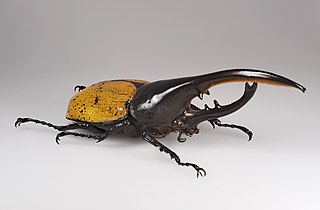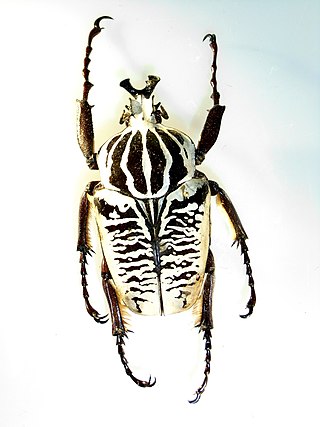
Beetles are insects that form the order Coleoptera, in the superorder Holometabola. Their front pair of wings are hardened into wing-cases, elytra, distinguishing them from most other insects. The Coleoptera, with about 400,000 described species, is the largest of all orders, constituting almost 40% of described insects and 25% of all known animal species; new species are discovered frequently, with estimates suggesting that there are between 0.9 and 2.1 million total species. Found in almost every habitat except the sea and the polar regions, they interact with their ecosystems in several ways: beetles often feed on plants and fungi, break down animal and plant debris, and eat other invertebrates. Some species are serious agricultural pests, such as the Colorado potato beetle, while others such as Coccinellidae eat aphids, scale insects, thrips, and other plant-sucking insects that damage crops. Some others also have unique characteristics, such as the common eastern firefly, which uses a light-emitting organ for mating and communication purposes

Cetonia aurata, called the rose chafer or the green rose chafer, is a beetle, 20 millimetres long, that has a metallic structurally coloured green and a distinct V-shaped scutellum. The scutellum is the small V-shaped area between the wing cases; it may show several small, irregular, white lines and marks. The underside of the beetle has a coppery colour, and its upper side is sometimes bronze, copper, violet, blue/black, or grey.

Trogidae, sometimes called hide beetles, is a family of beetles with a distinctive warty or bumpy appearance. Found worldwide, the family includes about 300 species contained in four or five genera.

The Hercules beetle is a species of rhinoceros beetle native to the rainforests of southern Mexico, Central America, South America, and the Lesser Antilles. It is the longest extant species of beetle in the world, and is also one of the largest flying insects in the world.

Dynastes tityus, the eastern Hercules beetle, is a species of rhinoceros beetle native to the Eastern United States. The adult's elytra are green, gray or tan, with black markings, and the whole animal, including the male's horns, may reach 60 mm (2.4 in) in length. The larvae feed on decaying wood from various trees.

The Goliath beetles are any of the five species in the genus Goliathus. Goliath beetles are among the largest insects on Earth, if measured in terms of size, bulk and weight. They are members of subfamily Cetoniinae, within the family Scarabaeidae. Goliath beetles can be found in many of Africa's tropical forests, where they feed primarily on tree sap and fruit. Little appears to be known of the larval cycle in the wild, but in captivity, Goliathus beetles have been successfully reared from egg to adult using protein-rich foods such as commercial cat and dog food. Goliath beetles measure from 60–110 millimetres (2.4–4.3 in) for males and 50–80 millimetres (2.0–3.1 in) for females, as adults, and can reach weights of up to 80–100 grams (2.8–3.5 oz) in the larval stage, though the adults are only about half this weight. The females range from a dark chestnut brown to silky white, but the males are normally brown/white/black or black/white.

Cotinis nitida, commonly known as the green June beetle, June bug or June beetle, is a beetle of the family Scarabaeidae. It is found in the eastern United States and Canada, where it is most abundant in the South. It is sometimes confused with the related southwestern species figeater beetle Cotinis mutabilis, which is less destructive.

Goliathus albosignatus is a species of beetle of the family Scarabaeidae, described by Boheman in 1857. It is one of several species of Goliath beetles that inhabit Africa, but it is the only one exclusively found in subtropical sections of the continent.

Goliathus goliatus is a very large species of beetle of the family Scarabaeidae, native to tropical Africa.

Goliathus orientalis is a species of beetles belonging to the family Scarabaeidae.

Melolonthinae is a subfamily of the scarab beetles. It is a very diverse group; distributed over most of the world, it contains over 11,000 species in over 750 genera. Some authors include the scarab subfamilies Euchirinae and Pachypodinae as tribes in the Melolonthinae.

Macrodactylus subspinosus is a North American beetle of the family Scarabaeidae. The members of its genus are known as "rose chafers", not to be confused with the European rose chafer, Cetonia aurata. M. subspinosus occurs from Eastern Canada to Colorado and is considered a pest of many crops and flowers. It is given its common name of rose chafer because it eats the leaves of roses, although it also feeds on many other plants.

Nicrophorus interruptus is a species of burying beetle or sexton beetle belonging to the family Silphidae subfamily Nicrophorinae.

Anoplotrupes stercorosus, the dor beetle, is a species of earth-boring dung beetle belonging to the family Geotrupidae, subfamily Geotrupinae.
Brachypsectra fulva is a species of beetle in the Brachypsectridae family commonly known as the Texas beetle.

Eudicella euthalia is a tropical, east African species of flower beetle in the genus Eudicella, belonging to the subfamily Cetoniidae.

Scelophysa trimeni, commonly known as the blue monkey beetle, is a species of scarab beetles in the tribe Hopliini, subfamily Melolonthinae.

Chondrorrhina abbreviata is a species of fruit and flower chafers belonging to the family Scarabaeidae, subfamily Cetoniinae.

Eudicella smithii is a species of African scarab beetle in the subfamily Cetoniinae, the flower beetles.

Dytiscus semisulcatus, the brown-bellied great diving beetle , is an aquatic diving beetle native to Europe and northern Asia, and is particularly common in England. It is a large dark red-brown or black beetle, that can fly and lives near water.






















